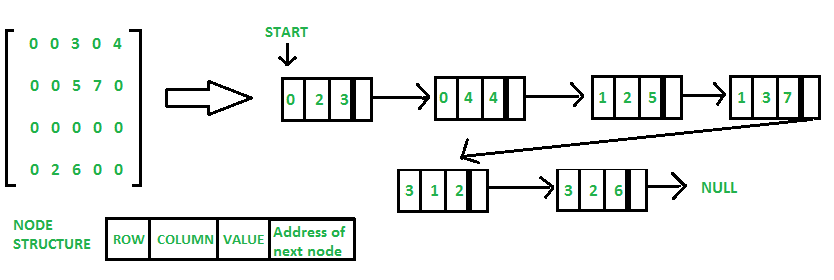A matrix is a two-dimensional data object made of m rows and n columns, therefore having total m x n values. If most of the elements of the matrix have 0 value, then it is called a sparse matrix.
Why to use Sparse Matrix instead of simple matrix ?
- Storage: There are lesser non-zero elements than zeros and thus lesser memory can be used to store only those elements.
- Computing time: Computing time can be saved by logically designing a data structure traversing only non-zero elements..
Example:
0 0 3 0 4 0 0 5 7 0 0 0 0 0 0 0 2 6 0 0
Representing a sparse matrix by a 2D array leads to wastage of lots of memory as zeroes in the matrix are of no use in most of the cases. So, instead of storing zeroes with non-zero elements, we only store non-zero elements. This means storing non-zero elements with triples- (Row, Column, value).
Sparse Matrix Representations can be done in many ways following are two common representations:
- Array representation
- Linked list representation
Method 1: Using Arrays:
2D array is used to represent a sparse matrix in which there are three rows named as
- Row: Index of row, where non-zero element is located
- Column: Index of column, where non-zero element is located
- Value: Value of the non zero element located at index – (row,column)

Method 2: Using Linked Lists
In linked list, each node has four fields. These four fields are defined as:
- Row: Index of row, where non-zero element is located
- Column: Index of column, where non-zero element is located
- Value: Value of the non zero element located at index – (row,column)
- Next node: Address of the next node

// C program for Sparse Matrix Representation
Output:
row_position: 0 0 1 1 3 3 column_postion: 2 4 2 3 1 2 Value: 3 4 5 7 2 6
Other representations:
As a Dictionary where row and column numbers are used as keys and values are matrix entries. This method saves space but sequential access of items is costly.
As a list of list. The idea is to make a list of rows and every item of list contains values. We can keep list items sorted by column numbers.




No comments:
Post a Comment